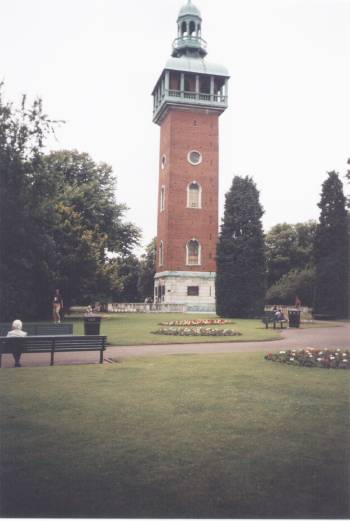![]()

![]()
On Monday 5th July, which was a beautiful warm sunny day, I made my way up to Waterlooville with a suitcase, to catch the 8.15.am Wallace Arnold coach to begin my journey to Loughborough.
When the Feeder coach arrived, there were only four passengers, plus we had to pick up one at Aldershot, travelling via the A3M Motorway, the A3 by-pass, and the A325, passing the wooded scenery and the border of the Army Ranges of Longmoor and Bordon, then the Military town of Aldershot for our final pick-up. Afterwards we made our way via the M25 and M1 to Toddington Service Station, which is just outside Luton for our Interchange to Loughborough.
The journey was mostly along the M1 with an hour's comfort stop at the Watford Gap, as our coach driver could phone The Kings Head Hotel to estimate our time of arrival at Loughborough which was about 2.45.pm, well in time for our evening meal at 7.pm. The Hotel building with its 78 comfortable en-suite rooms, is a large Georgian Architecture design, and is built around a relaxing, continental style courtyard with a fountain, and is situated amongst the very busy High Street in the Town Centre.
On Tuesday the 6th, the first highlight of the holiday began, as we set off at 10.30.am after a full breakfast for a day's outing on the Great Central Railway to Leicester. We made the 10 minute coach trip to Loughborough Central Station in time to catch the 11.05.am steam train. The scenery along the 8 mile journey was truly a beautiful and interesting experience, as the first station at Quorn & Woodhouse, was at one time during the second world war, a loading point for military traffic, which once contained several long sidings, but is now covered by tarmac. Many of the buildings have been restored as they were during the last war, with a N.A.F.F.I. style canteen which opens at weekends.
As we continued, the train crossed over two viaducts above the beautiful Swaithland Reservoir, which is a nature reserve for bird life, and was constructed during the late 19th Century to supply water for the City of Leicester. The next station we arrived at was Rothley, which is a beautiful Edwardian building, complete with working Gas lamps and operational signal box, a tiny goods office, with waiting and refreshment rooms. The station provides a nearby picnic area with car-parking facilities, and is the location of the carriage restoration Depot.
The terminus at Leicester North Station, consists of a single platform, and is situated within the City boundary. The steam trains stop here, and allow the passengers to watch the locomotives being detached and run round the carriages for the return trip. At Loughborough Central, we were allowed to view the Locomotive sheds and main workshop. Here they have many locomotives and rolling stock. The station itself also had a second world war theme with museum and gift shop.
On Wednesday the 7th, we had a free day at leisure. I chose to travel by train to Leicester, which had a frequent service and took 15 minutes from Loughborough, and arrived at 9.45.am. I didn't have a street map, but the main attractions were well sign posted, before I knew it, I was in the Castle Park, Leicester's Old Town area, which has its Cathedral and many fine and interesting buildings. I found the Cathedral of St Martins very lovely and peaceful, which had a lot of Victorian history in its past, as the verger kindly showed a small party of us around, with many fine stained glass windows and beautiful chapels. After saying a prayer and lighting a candle, I visited the street markets and the enormous Indoor Shires Shopping Centre. I never realized how busy and compact the city is, let alone the many sets of traffic lights, and extremely heavy traffic flow. I stayed there till about one o'clock, because the heat was uncomfortable, and made the train journey back to Loughborough.

Carillon Tower
I spent the afternoon touring the town and in the beautiful grounds of Queens Park, climbing the spiral staircase of the Carillon Tower, which on the ground, first and second floors, contains a first and second world war museum, dedicated to the men and women of the town. On the top floor, is housed a group of bells attached to wire and cables from a keyboard, which you can view on the third floor. Sometimes they have recitals with the bells playing, which unfortunately, they had a few days before we had arrived.
On Thursday the 8th, we left our Hotel at 9.30.am for the second highlight of our holiday, with a full day trip to the National Tram Museum at Crich. It was founded in 1955 and incorporated in 1962. Here they have many working tram rides all day, with museums on the development of Tramways in Britain, since the introduction in the 1800's to their decline in the 1960's (although in some parts of Britain, they are making a come back). At Crich, they have a 2½ mile Tram-Track ride from which you can view a working Quarry, Electric Sub-Station which supplies power for the trams, wooded scenery and the overall view of the idyllic Derwent Valley, along the route.
On Friday the 9th, we made our way home. During my holiday, I met some really lovely people, one of whom was blind and travelling with his mother, and some other disabled people. It was a treat to see so much countryside with the trees, sheep, cattle, and horses grazing in the fields, and thanking god for the unspoilt beauty and travelling companions I have met.
written by Leon Bartosiak
![]() Return to the September 1999 Features page
Return to the September 1999 Features page
![]() return to Home page and main index
return to Home page and main index
page last updated 22 AUGUST 1999